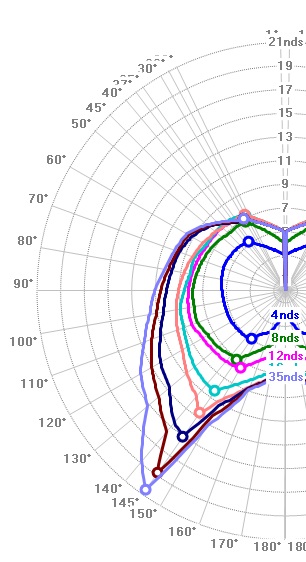Les voiles du Jouet
Cliquer sur le titre (avec ![]() ) pour ouvrir ou refermer.
) pour ouvrir ou refermer.
Chaque voile a une page dédiée à retrouver en cliquant sur le lien en bout de ligne du tableau ci-dessous
| Voiles autorisées par la jauge J111 OD: (règles de classe J111 version 2011 - 05 en anglais) |
|
|
|
LesVoiles |
M² Maxi | Divers | Date | Voilerie | Type | Matière | Code interne |
| Grand Voile | 37 | 01/08/2011 | Intuitive Sails | Membrane | Trilam Black Technora | GVA | |
| Grand Voile | 37 | 01/03/2017 | Intuitive Sails | Membrane | Membrane Like D4 | GVB | |
| Solent Light | 33 | 25/12/2011 | Intuitive Sails | Membrane | D4 FastlineAramid | J1A | |
| Solent Heavy | 30 | 01/08/2011 | Intuitive Sails | Membrane | Trilam Black Technora | J2A | |
| Orc | 23 | 26/08/2011 | Intuitive Sails | Verticale | Aramid X15 Clear | J3A | |
| Spi Base 40g | 130 | Rouge | 01/08/2011 | Intuitive Sails | Orienté | Dynakote 75 | S1 |
| Spi Vmg | 107 | Rouge | 25/12/2011 | Intuitive Sails | Orienté | Superkote 90 | S2 |
| Spi Largue | 78 | Vendu 06/15 | 24/09/2011 | Intuitive Sails | Orienté | AIRX-900N. | S3 |
| Spi Max 40g | 130 | Vendu 11/17 | 09/04/2015 | Intuitive Sails | Orienté | Superkote 75 | S4 |
| Spi Largue | 80 | Vendu 12/15 | 01/08/2015 | Intuitive Sails | Orienté | AIRX-900N. | S5 |
| Spi Largue | 80 | Rouge | 10/01/2016 | Intuitive Sails | Orienté | AIRX-900N. | S6 |
La décision est prise ... c'est Intuitive Sails le Crouesty dirigé par Sylvain Pellissier qui sera de l'aventure, étant donné les bonnes relations et les bons résultats obtenus en J105 avec J'Adore depuis le début de notre collaboration à fin 2008 |
J105 J'ADORE et Intuitive Sails |
Le plaisir d'utiliser des chariots de mât sur la GV et un foc à enrouleur sur le J111 Le Jouet
Depuis la tourelle de sortie du port de Pornichet (vu en début de vidéo)
et la navigation sous voiles trois minutes pour tout régler sans ce presser.
 Plus d' images de mon J111 "Le Jouet" sous voiles en cliquant ici (défilement haut et bas)
Plus d' images de mon J111 "Le Jouet" sous voiles en cliquant ici (défilement haut et bas)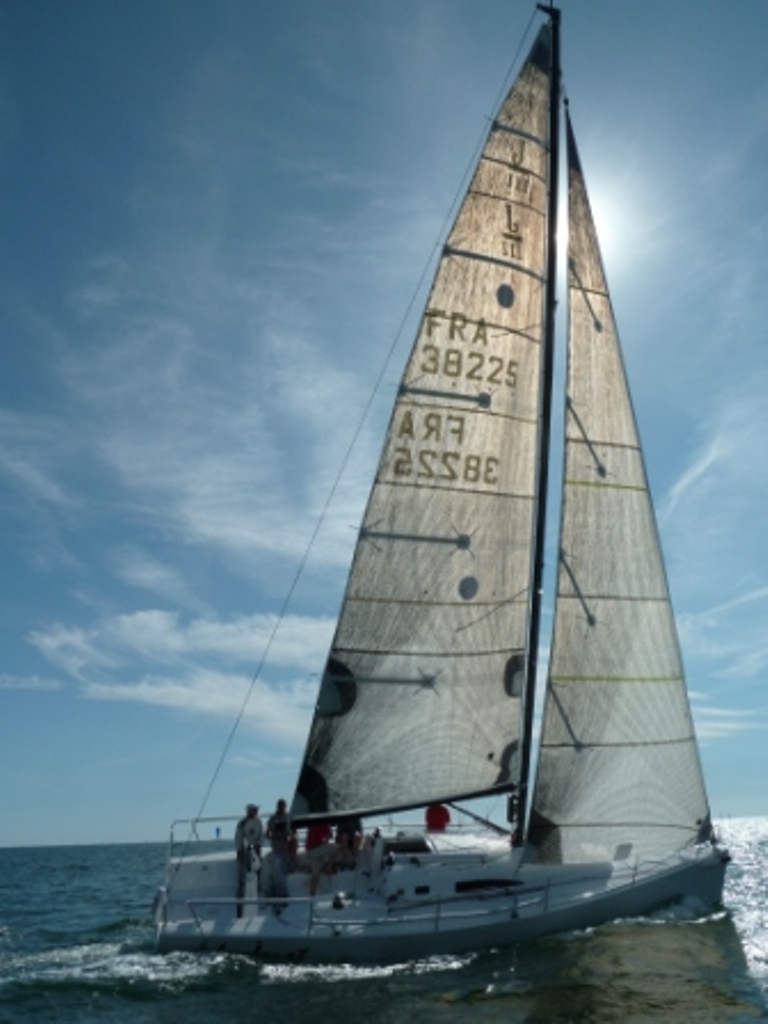
-

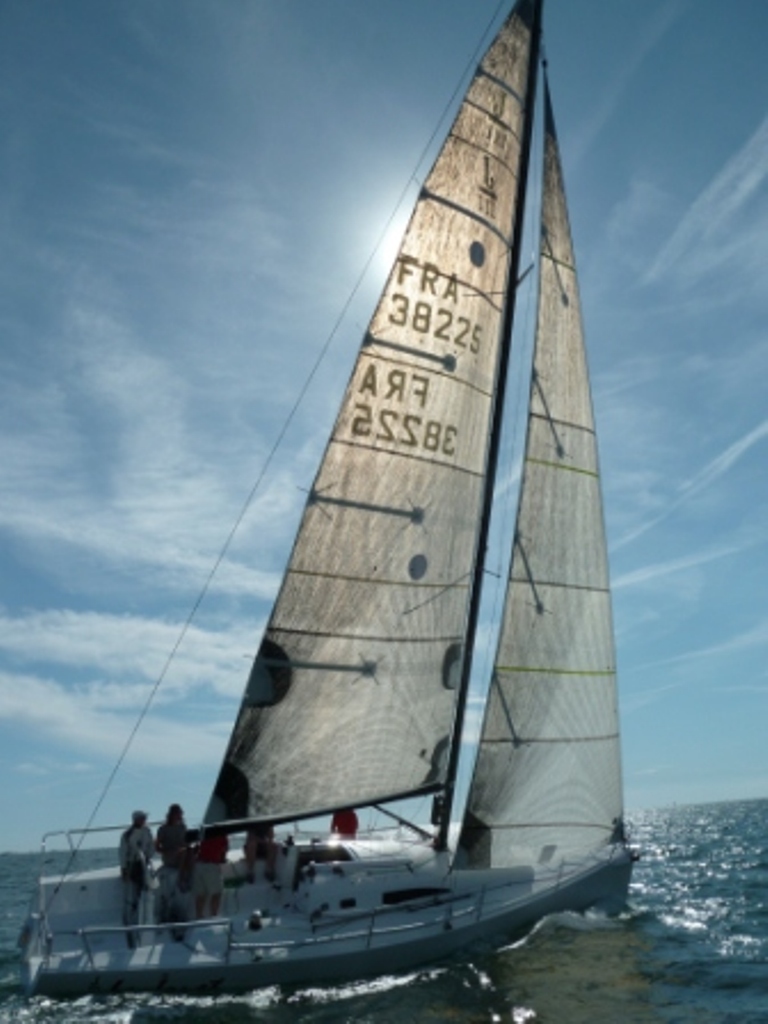
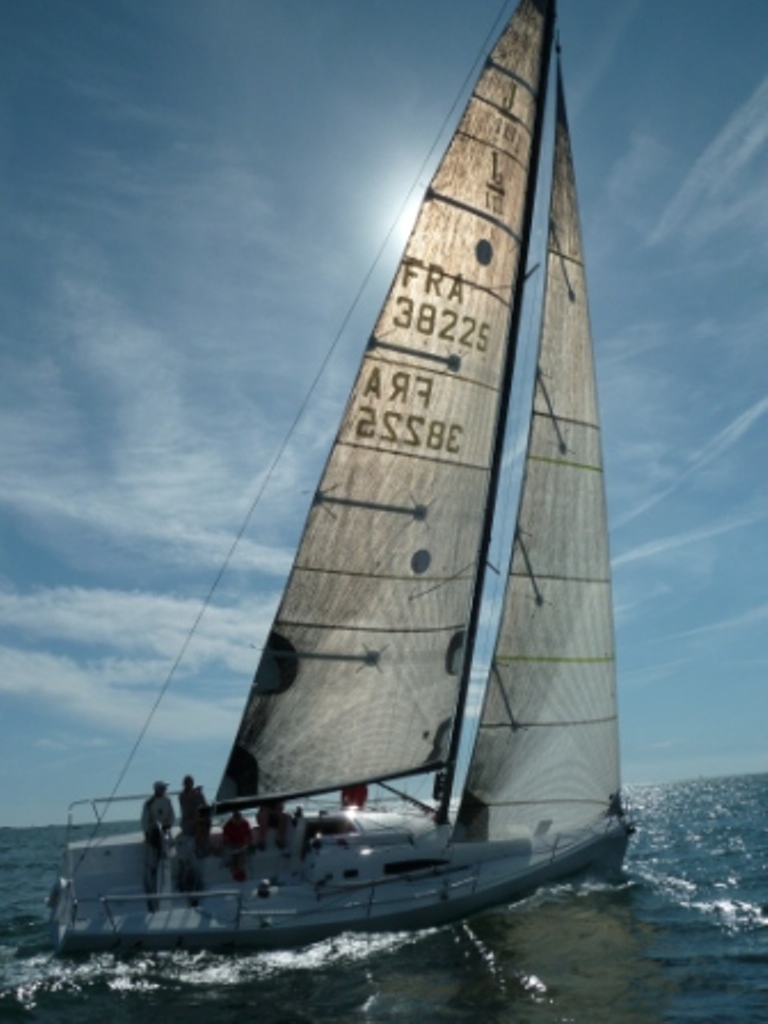
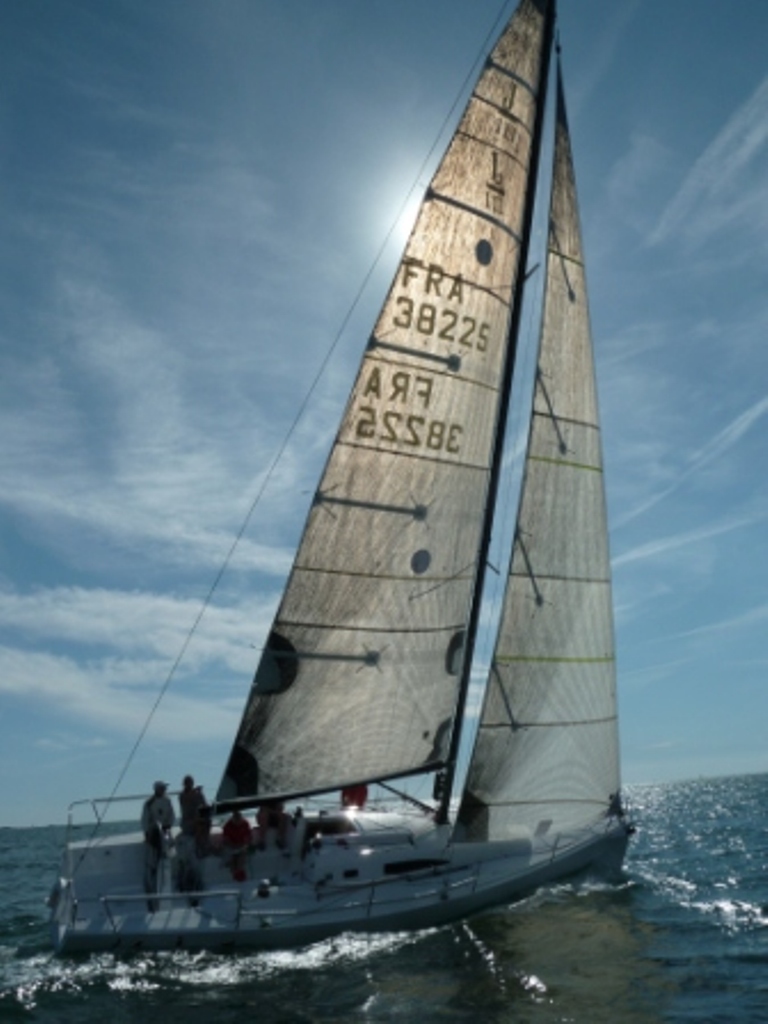
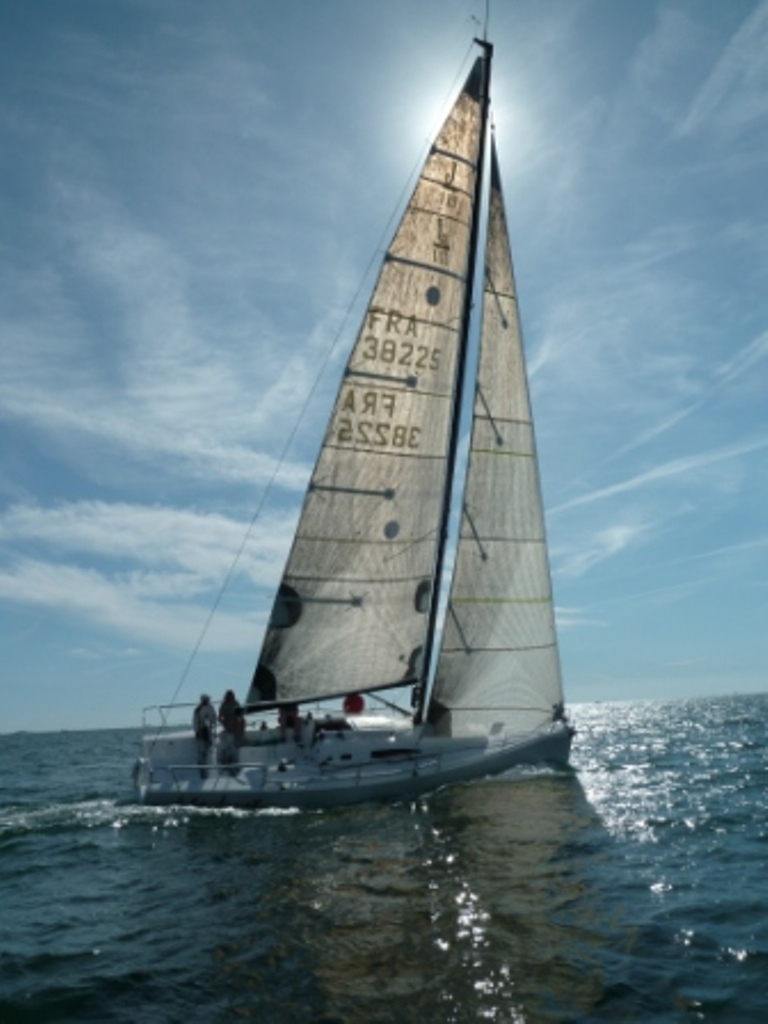
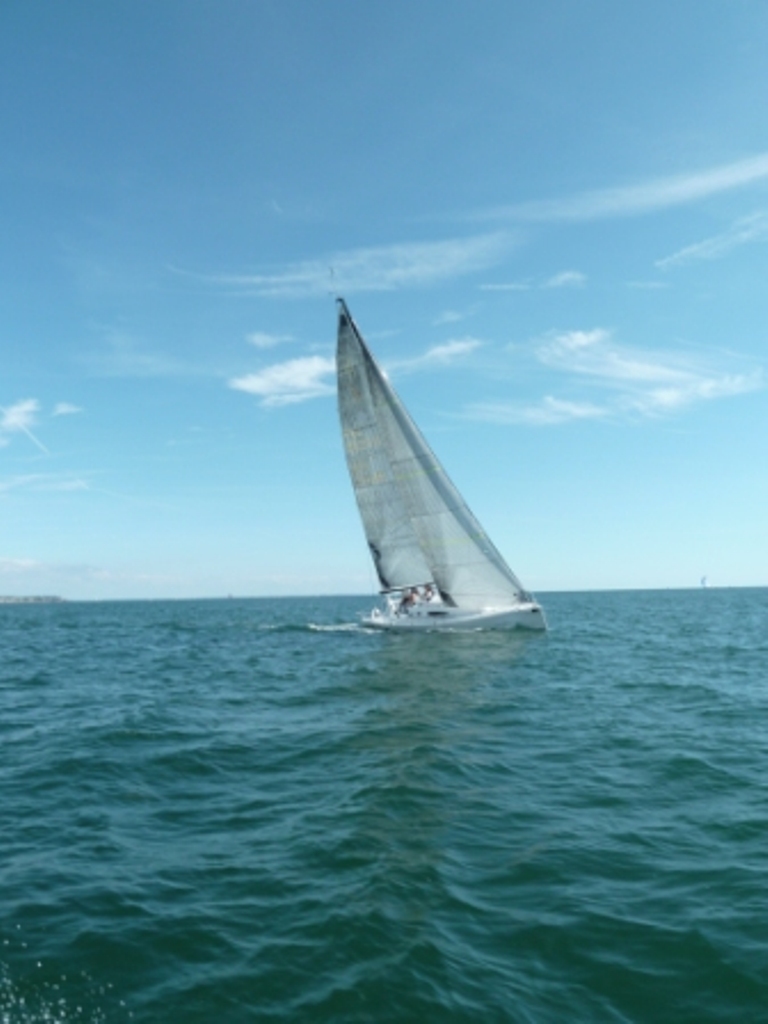
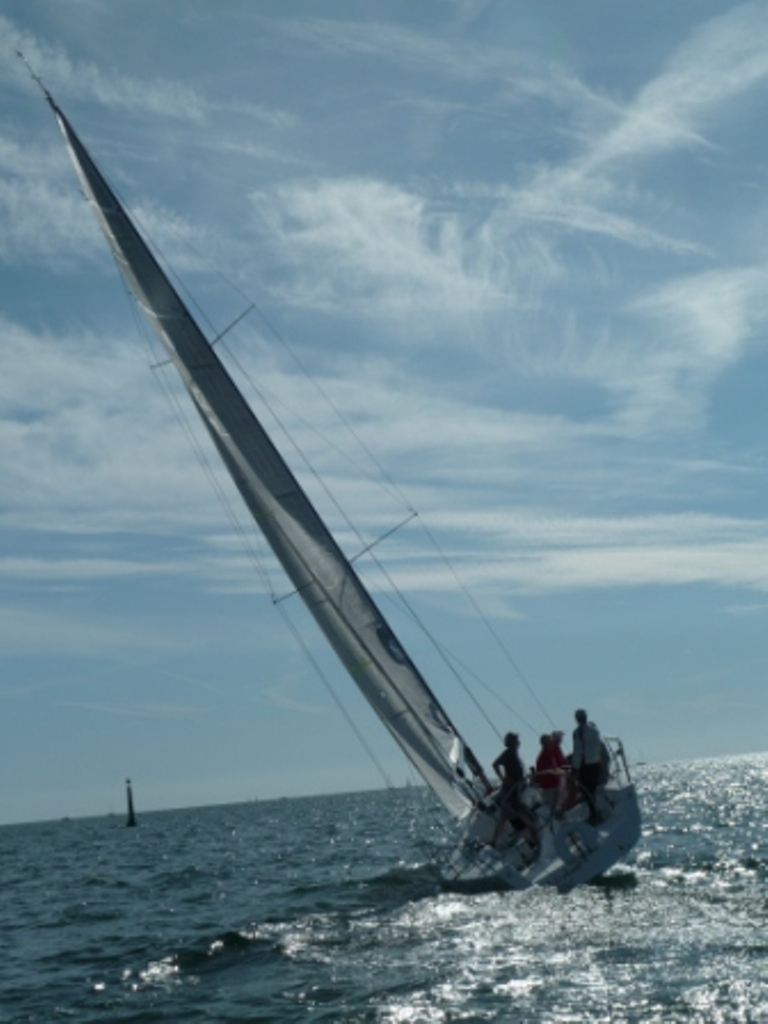
 Merci à Camille Leplat pour ces quelques images
Merci à Camille Leplat pour ces quelques images -

Mode de calcul de la surface des spis (maxi, 130 m²).
SA=(luff length + leech length) * 0.25 foot length + (half width- 0.5 foot length) * (leech length + lufflength) / 3.
Calculez votre spi (Tableau Excel)
Plan de voilure Piranha
Règles de classe J111 Voiles
Section G – Sails
G.1 PARTS
G.1.1 MANDATORY
(a) 1 Mainsail
(b) 1 Headsail
(c) 1 Asymmetric Spinnaker
G.1.2 OPTIONAL (UNLESS MADE MANDATORY)
(d) 1 Additional Headsail
(e) 1 OSR Heavy Weather Jib
(f) 1 Additional Asymmetric Spinnaker
(g) 1 Storm Trysail
(h) 1 Storm Jib
G.2 GENERAL
G.2.1 RULES
(a) Sails shall comply with the class rules in force at the time of
certification.
G.2.2 CERTIFICATION
(a) The official measurer or In-House Official Measurer shall certify
mainsails and headsails in the tack and spinnakers in the head and shall
sign and date the certification mark.
(b) The ISAF or an MNA may appoint one or more In-House Official
Measurers to measure and certify sails produced by that manufacturer..
G.2.3 SAILMAKER
(a) No licence is required.(b) For spinnakers the weight in g/m
2
of the body of the sail shall be indelibly
marked near the head point by the sailmaker together with the date and
his signature or stamp. For sails certified after 1 January 2012, in
addition
the maker and style of sail cloth shall be marked by the sailmaker.
G.2.4 J/111 SAIL ROYALTY LABEL - TBD
G.2.5 MODIFICATIONS, MAINTENANCE AND REPAIR
If any sail is damaged and requires repair in any other way than described
in
section C, the sail will require re-certification which may require
fundamental measurement.
G.3 MAINSAIL
G.3.1 IDENTIFICATION
(a) The class insignia available from J/Boats shall conform with the
dimensions and placed in accordance with the diagram contained in
Appendix H-1.
G.3.2 MATERIALS
(a) The ply fibres shall consist of woven ply and/or laminated ply made
from
one or more of the following materials: polyester, aramid, PEN, HMPE
and carbon fiber.
(b) Sail reinforcement shall be made from one or more of the following
materials: polyester, aramid, PEN, HMPE and carbon fiber.
G.3.3 CONSTRUCTION
(a) The construction shall be: soft sail; single ply or laminated ply
sail.
(b) The body of the sail shall consist of the same ply throughout.
(c) The sail shall be constructed with at least one serviceable set
of reef points,
meaning one point adjacent to the luff, one point adjacent to the leech
and
four corresponding points in the body of the sail. The lowest set of
reef
points shall be installed no closer than 1500 mm to the foot.
(d) The mainsail shall have five batten pockets in the leech. The top
batten
pocket shall be full length extending from luff to leech. Other battens
pockets may be of any length.
(e) The following are permitted: Stitching, glues, tapes, bolt ropes,
corner
eyes, headboard with fixings, Cunningham eye or pulley, batten pocket
patches, batten pocket elastic, batten pocket end caps, mast and boom
slides, leech line with cleat, one window, tell tales, sail shape indicator
stripes and items as permitted or prescribed by other applicable rules.
(f) The leech shall not extend aft of straight lines between:
(1) the aft head point and the intersection of the leech and the upper
edge
of the nearest batten pocket,
(2) the intersection of the leech and the lower edge of a batten pocket
and the intersection of the leech and the upper edge of an adjacent
batten pocket below,(3) the clew point and the intersection of the leech
and the lower edge of
the nearest batten pocket.
G.3.4 DIMENSIONS
Half width 3080 mm
Three-quarter width 1880 mm
Mainsail upper leech point is defined as the point
on the leech equidistant from the head point and
the three quarter leech point.
Upper width 1060 mm
Top width 210 mm
Head point to intersection of leech and centreline
of uppermost batten pocket
2400 mm 2420 mm
The weight of the mainsail (without battens) 18 kg
G.4 HEADSAIL
G.4.1 MATERIALS
(a) The ply fibres shall consist of woven ply and/or laminated ply made
from
one or more of the following materials: polyester, aramid, PEN, HMPE
and carbon fiber.
(b) Sail reinforcement shall be made from one or more of the following
materials: polyester, aramid, PEN, HMPE and carbon fiber.
G.4.2 CONSTRUCTION
(a) The construction shall be: soft sail; single ply or laminated ply
sail.
(b) The body of the sail shall consist of the same ply throughout.
(c) The headsail shall have no more than 4 batten pockets in the leech.
Batten material is optional.
(d) The following are permitted: Stitching, glues, tapes, corner eyes,
batten
pocket elastic, batten pocket patches, batten pocket end caps, leech
line
with cleat, one window, tell tales, sail shape indicator stripes, UV
protective may be applied to the leech and foot to cover the sail when
furled; and items as permitted or prescribed by other applicable rules.
(f) The recommended luff tape is 4.5mm to be capable with the forestay
foil.
G.4.3 DIMENSIONS
minimum maximum
Luff length - 14500 mm
Luff Perpendicular - 4450 mm
Half width - 2400 mm
Three-quarter width - 1295 mm
Top width - 100 mm
Foot irregularity - mm
The weight of the headsail (without battens) 11.5 kg -minimum maximum
Primary reinforcement and Secondary
reinforcement
Unlimited
G.5 OSR HEAVY WEATHER HEADSAIL
G.5.1 RULES
(a) In addition to the general rule the sail shall comply with the ISAF
Offshore
Special Regulations heavy weather jib requirements.
G.5.2 MATERIALS
(a) The ply fibres shall consist of woven ply and/or laminated ply made
from
one or more of the following materials: polyester, aramid, PEN, HMPE
and carbon fibre.
G.5.3 CONSTRUCTION
(a) The construction shall be: soft sail, single ply sail.
(b) The body of the sail shall consist of the same woven ply throughout.
(c) The leech shall not extend beyond a straight line from the aft head
point
to the clew point.
(d) The sail shall have no more than 4 batten pockets in the leech.
(e) The following are permitted: Stitching, glues, tapes, corner eyes,
batten
pocket elastic, batten pocket patches, batten pocket end caps, leech
line
with cleat, one window, tell tales, sail shape indicator stripes, UV
protective may be applied to the leech and foot to cover the sail when
furled; and items as permitted or prescribed by other applicable rules.
G.5.4 DIMENSIONS
minimum maximum
Luff length - 13000 mm
Luff Perpendicular
Primary reinforcement and Secondary
reinforcement:
- 3900 mm
unlimited
G.6 ASYMMETRIC SPINNAKER
G.6.1 MATERIALS
(a) The ply of the body of the sail shall be manufactured from woven
nylon
(b) Mass of ply of the body of the sail not less than 40 g/m
2
(b) Sail reinforcement shall consist of….
G.6.2 CONSTRUCTION
(a) The construction shall be: soft sail, single ply sail.
(b) The body of the sail shall consist of the same woven ply throughout.
(c) The following shall be fitted: Adjustable leech, luff and foot lines(d)
The following are permitted: Stitching, glues, tapes, corner eyes, recovery
line eyes, tell tales and items as permitted or prescribed by other
applicable
rules.
G.6.3 DIMENSIONS
The area of the sail (“SA”) shall not exceed 130 square meters, based
on
the formula:
Sail Area = ((luff length + leech length) x (0.25 foot length))
+ ((half width - 0.5 foot length) x ((leech length + luff length) /
3)).
G.7 ADDITIONAL ASYMMETRIC SPINNAKER
If a second asymmetric spinnaker is carried aboard, it shall meet the
requirements of #G.6 above except the mass of the ply of the body of
the sail
shall be not less than 36 g/m2.
G.8 OSR STORM TRYSAIL
Shall be in accordance with the ISAF Offshore Special Regulations
G.9 OSR STORM JIB
Shall be in accordance with the ISAF Offshore Special Regulations
| Voiles | GVA | GVB | J1A | J2A | J3A | S1 | S2 | S3 | S4 | S5 | S6 |
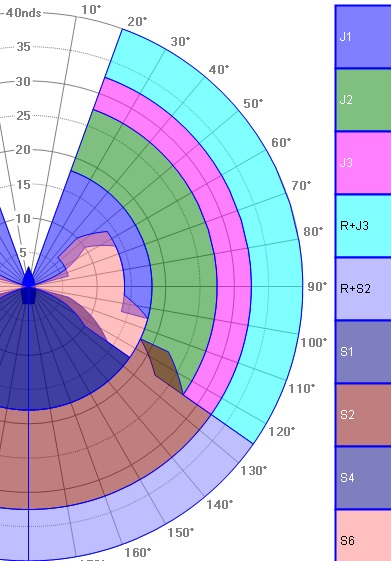
| J1A Médium |
| J2A Lourd |
| J3A ORC |
| R = Un ris |
| R = Un ris |
| A1.5 Tête |
| A2 Capelage |
| A1.5 Tête (neuf) |
| Code 0 |
